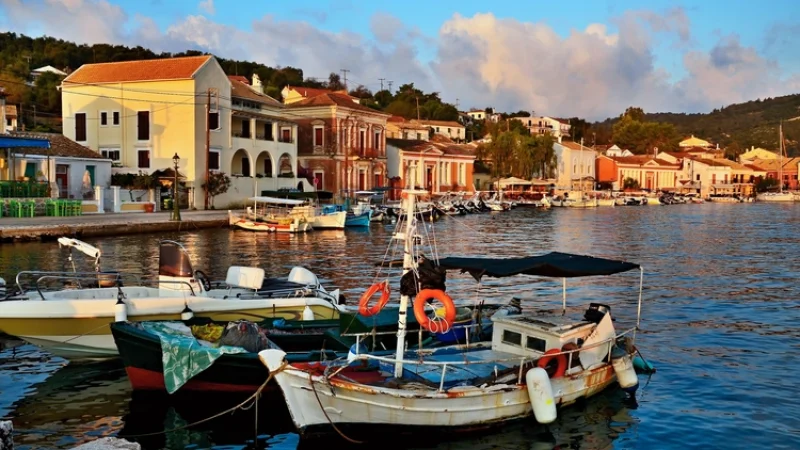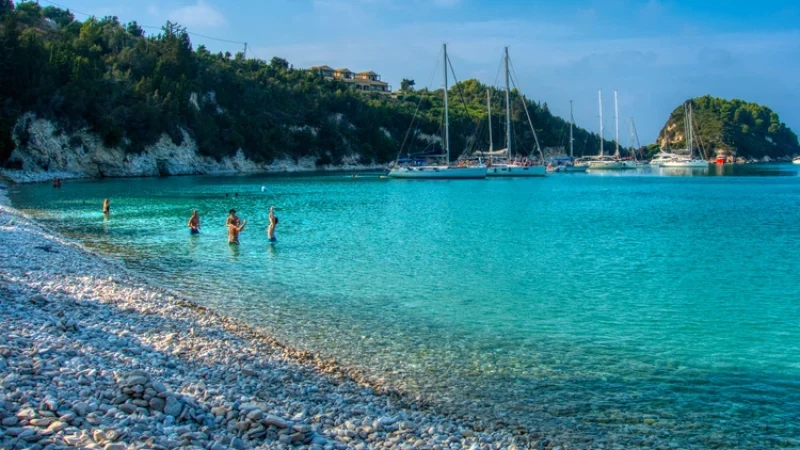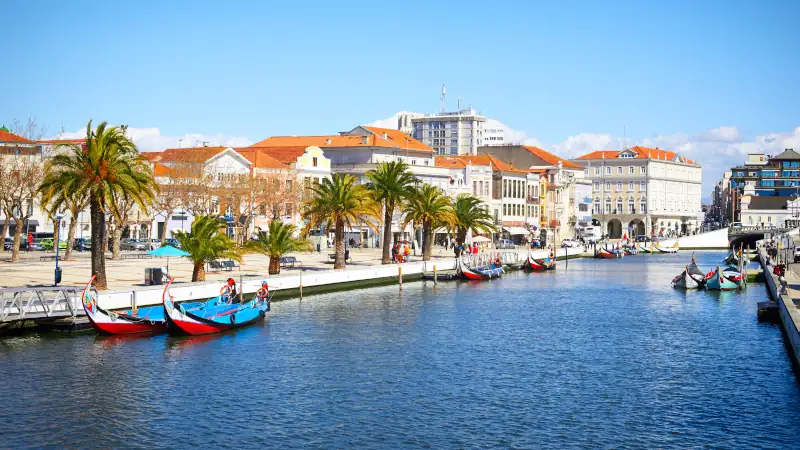Paxos, Greece: Ideal For Living A Mediterranean Life
Greek history is so ancient, the details of important events are often intertwined with mythology… Paxos’s history is no different.
According to legend, the island was formed when Poseidon hurled his trident at Corfu, causing a chunk of land to break off its southern tip. That chunk of land is Paxos. It became a love retreat for Poseidon and his mistress. When his trident was later found by Paxos residents, it became the emblem of the island.
Paxos is the smallest of Greece’s Ionian Islands. At only 10 kms long and about 3 kms wide, Paxos truly qualifies as tiny. But while its geographic area is limited, its natural beauty, local charm, and culinary creativity are boundless.
Paxos’s peaks and valleys are heavily forested by Mediterranean cypresses, kermes oak, and wild olive trees. Because it’s so small, Paxos can easily be discovered on foot or motorbike (or bicycle if you don’t mind the hills).
To get the very best out of Paxos, you have to take to the sea… Plus, the real appeal of life here for so many expats is the boating lifestyle it affords… whether it’s island-hopping on a no-frills motorboat or cruising around on a luxury yacht, on a mission to see and be seen.
Paxos lends itself well to the high-end way of life if that’s what you’re after… But it’s also traditional at its core, with Greek cultural values—family, hospitality, religion, and so on—felt strongly.
Though small in size, Paxos is big with potential for a life full of peace, serenity, and Mediterranean bliss.
Expats In Paxos, Greece
Paxos has a population of about 2,300 people. Of that number, 50 to 60 are expat retirees who live here permanently. Many more are part-timers.
The hub of Paxos’s expat community is The Paxos Grapevine—an active and well-used Facebook group. It’s a public group with over 5,000 members and a great source of information about events, items for sale, news, and general things of interest.
he permanent expat community blends in well with the local community… Many are semi-fluent in Greek and socialize just as readily with locals as they do foreigners.
Events are hosted regularly. It’s not hard to meet people and develop a network of friends and contacts on an island this small.
Greece still offers a golden visa program—one of the few remaining in Europe. Investors can gain residency by spending 250,000 euros on real estate in a low-density area of the country or 500,000 euros on real estate in a high-density area (Athens, Thessaloniki, and elsewhere).
Cost Of Living In Paxos, Greece
Paxos has easygoing people eager to help you get what you need…
While Greek may not be the easiest language to pick up in retirement, folks working in the big cities and tourist sites here will speak enough English for you to get by.
Most importantly, you’ll find a few English speakers if needed even in the lesser traveled areas around the island. When all else fails, locals are patient and happy to help you be understood in a smattering of “Greeklish.”
Greece’s reputation as a bona fide beach destination is well-founded: With the longest coastline in the Mediterranean Basin and unique geography full of islands and peninsulas.
Despite being an island and attracting wealthy yacht enthusiasts, Paxos is affordable.
A couple would need about US$2,000 a month (give or take a couple hundred dollars) to live a comfortable life on Paxos.
In short, your most-significant expense will be rent, which varies depending on size, location, and how new the accommodation is.
Things To Do In Paxos, Greece
Paxos is an ocean and beach-lover’s paradise. But there’s so much this tiny island has for you to do.
1. Explore The Beaches In Paxos
There are at least 15 beaches around Paxos… but then again, when you’re on an island, anywhere can be a beach. Along Paxos’s southeast coast, the shoreline is made up of rock shelves.
To make up for the lack of beach, people have affixed metal pool ladders directly into the rocks. There’s no wrong place to go for a dip in Ionian Sea…
Erimitis Bay Beach features bright, cyan-blue waters framed by dramatic white cliffs. It’s one of the best places on the island to watch the sun set. It’s a long hike down (and then back up) to Erimitis Bay Beach, but the view you’re rewarded with once you get there is worth it.
Meattie Buir’s Beach is a quiet beach that’s tucked away around the corner from Lakka. It’s also on the west coast and surrounded by cliffs, with lots to see both above and below water. The water is crystal clear, and there are big boulders underwater that you can perch on, taking a rest while you swim or snorkel.
Note that this is a popular spot among nudists because, so few people visit it.
Kaki Lagkada Beach’s views aren’t as spectacular as Erimitis or Meattie Buir’s, but the beach is spacious, the waters are clear and clam, and there’s a top-notch beach bar nestles in its cove
2. Dive Into The History And Culture Of Paxos
All around Greece, there’s evidence of this country’s incredible ancient history.
On Paxos, the most eye catching monument is Agios Nikolaos Castle, dating back to the 15th century. It was built by Adam II San Ippolito, a Venetian lord, on Agios Nikolaos Island to protect against pirate and Ottoman attacks.
Unattended and unmarked ruins are scattered around the island, making you feel like you’ve stepped back in time when you stumble upon them. One such ruin is the Basilica of Agia Marina, the oldest basilica on Paxos. You’ll also find the ruins of several cisterns, the Cisterns of Sarakinos being the most famous among them.
Paxos Museum is a good destination to get a dose of history and culture. Housed in a 115-year-old former schoolhouse, it takes you on a journey of Paxos’s history of human habitation. This starts with flint tools from the Paleolithic and ends with clothing and accessories from the turn of the 20th century.
There’s also an olive press museum and a folklore museum on Paxos… but that’s it.Paxos is not really a destination for “high culture”—theater, opera, symphony performances, fine art… It’s a place for people who enjoy simple pleasures, like nice meals, time spent with family and friends, and frequent dips in the ocean.
3. Taste The Local Cuisine
The best way to connect with Paxos’s culture is through its cuisine… there’s no shortage of excellent places to eat and drink here. Eating out is an inexpensive indulgence, and the service is caring and professional.
For example, you can visit local taverns and restaurants and get a taste of exquisite fresh seafood, locally produced olive oil, and traditional dishes like moussaka and souvlaki.
4. Go On A Hike In Paxos
Paxos has several scenic hiking trails for you to explore. The trail from Gaios to Loggos is pretty popular. Some of these hiking trails will even take you through olive groves, vineyards, and picturesque villages.
Other hiking trails to consider are:
Safety In Paxos
Paxos is a small and peaceful island with a tight-knit community making this a very safe destination for foreigners. Locals are welcoming and hospitable, and the atmosphere is relaxed.
However, like anywhere else in the world, you should practice certain precautions to ensure you don’t become victim of petty theft or crime.
Be aware of your surroundings, avoid isolated or poorly lit areas at night, don’t flash your wallet or carry lots of cash, avoid wearing expensive jewelry, lock your homes and cars, and keep valuables out of sight. Don’t leave your stuff unattended and keep your belongings close to you when using public transportation or in crowded areas.
Health Care In Paxos
The Paxos Health Center is in Bogdanatika—a central location, quickly and easily accessed from most points on the island. The health center provides internal medicine, pediatrics, and dentistry services, and its doctors are well-equipped to handle many medical concerns, but not all.
Expats report they have used Paxos’s health center for minor procedures and emergencies and that the treatment has been fast, attentive, and professional. There is an ambulance on the island, but in an emergency, it’s normal to have a friend or neighbor drive you to the health center.
All that said, Paxos’s Health Center is a clinic, not a hospital. There’s a limit to the severity of issues it can treat. For serious concerns and complex procedures, patients are transferred to hospitals on Corfu or the mainland (either in a sea taxi, accompanied by the resident doctor, or in a helicopter).
The main hospital on Corfu is Corfu General Hospital, a public hospital providing pulmonary, intensive care, gynecology, pediatric, pathology, cardiology, surgery, orthopedics, and neurology clinics as well as external care medical units.
There are a few private clinics on Corfu.
The lack of a hospital in Paxos is a serious consideration… and may be a reason not to come here if you have a condition that requires constant monitoring. As a result, it depends on you, your assessment of your medical situation, and the level of risk you’re willing to take.
Visa And Residency Information For Paxos
When you visit Greece, you get 90 days on your tourist visa. This is the usual tourist stay time for all of the Schengen area.
Greece is part of the European Union, so it’s governed by the EU laws. It’s important to note this because many people forget this and travel to other European countries without realizing their time is up.
So, once you obtain another type of visa you can stay for as long as you want, up until the expiry date.
For residency visa options, Greece has the Digital Nomad visa, Work Permit visa, Financially Independent Resident visa, and of course, the Golden Visa.
The process is not easy, and it can be time consuming.
Weather In Paxos
Paxos enjoys a Mediterranean climate. Like the rest of Greece, it’s characterized by hot, dry summers and mild, wet winters.
Summer in Paxos runs from June to August. Temperatures average between 77°F (25°C) to 95°F (35°C).
Most importantly, July and August are the hottest months in Paxos with temperatures sometimes reaching over 90°F (over 30°C).
Fall runs from September to November. This season is usually warm and sunny in Paxos. Daytime temperatures range from 68°F (20°C) to 86°F (30°C). September is still a somewhat busy month for tourism, but October and November start seeing fewer visitors.
Winter in Paxos runs from December to February. This is the quietest time of the year. Temperatures typically range from 50°F (10°C) to 59°F (15°C). So, it can feel cooler due to the winds during this season.
Spring brings colorful wildflowers in full bloom and lush greenery. This is a beautiful season for Paxos. This season runs from March to May and temperatures range between 59°F (15°C) to 77°F (25°C).
Also, April and May are particularly pleasant months to visit Paxos as the weather is ideal and there are fewer tourists wandering around.
When you visit Greece, you get 90 days on your tourist visa. This is the usual tourist stay time for all of the Schengen area.
Greece is part of the European Union, so it’s governed by the EU laws. It’s important to note this because many people forget this and travel to other European countries without realizing their time is up.
So, once you obtain another type of visa you can stay for as long as you want, up until the expiry date.
For residency visa options, Greece has the Digital Nomad visa, Work Permit visa, Financially Independent Resident visa, and of course, the Golden Visa.
The process is not easy, and it can be time consuming.
















 . '
. '
 . '
. '
 . '
. '
 . '
. '
 . '
. '







